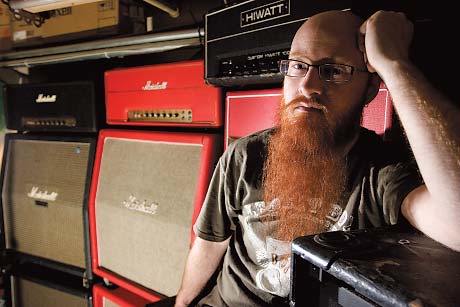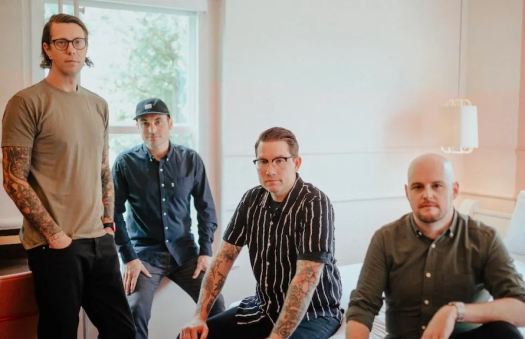"Im a gear pig. Ive got tons because Im a collector. The back wall of my bands rehearsal space is just my amps. Talking shop with Montreal-based Jonathan Cummins is a hydra, ranging from the live instruments he uses with gritty rockers Bionic, to the studio gear and tools that are applied to recording either his music or those he works with as a producer.
Regardless, many revere Cummins for his knowledge about musical instruments, recording and more importantly, his sound: thick and thunderous, yet full of crisp attack. Listening to Bionic albums such as Deliverance and latest effort Black Blood or seeing them live is like being that guy in the chair of a Maxell ad your hair blows back and you smile in awe.
"Its all vintage gear, he reveals. "Why? Maybe because I never owned a guitar when I was younger, I was always looking at stuff. I never owned a guitar until I was in the Doughboys. Even when vintage gear wasnt popular, I was into it, wanting that J. Mascis sound. I love Gibson, Fender and Gretsch. The new stuff? Unless youre buying custom, its crap. Theres a comfortable feel to vintage gear. I also love cheap guitars. To that extent, Cummins recites an endless list of amplifiers and guitars in his stable, ranging from pre-1973 Marshall heads to Fenders, five Marshall cabinets, a 1966 Fender Super Reverb, a Hayseed amplifier customised from a Vox AC30 with hemp speakers (he explains in detail their superiority over regular old paper ones) and more. Gear pig, indeed. The conversation rolls into guitars, of which Cummins estimates his fleet holds a value to the tune of around $14,000: a 1964 custom colour Fender Jazzmaster, a 65 Jazzmaster and a limited-edition 1980 Les Paul Heritage Series. Live, he swears by Marshall amps, preferring their heaviness offset by a Vox AC30 to get clarity. "You want to push air but have clarity, he demands.
Despite his adoration for the pre-loved equipment, Cummins admits that simply grabbing what he finds rarely produces the desired result. Retrofitting all of his gear with new wiring, pick-ups and electronic components, he likens his quest for the perfect sound to, "an obsessive guy working on a muscle car: its a constant goal you never quite get right.
"Im basically looking for tone, he admits, revealing his true goal in both live and recording capacities. "Its important for a guitarist to get their own sound. Thats what will make them unique. Ive taken that a step further, to the point where none of my gear is exactly the same as it was when it came out of the factory.
Even with an extensive collection of "toys we dont even touch on pedals and other effects Cummins feels there is a distinct difference as to what he will bring on the road and what is solely for recording purposes. "When you record, you have to realise that the end result all depends on interaction with microphones. You use different mic techniques depending on the amplifier. Some speakers have the right punch for say, an SM-57 microphone. I find Marshall sound I love it but with recording, you lose that clarity. When I record amps, I use three amps at once. You dont need to equalise the recording [because] you can switch high end or mid the tonal spectrum is bigger but the sound is tight because its the same performance.
Still, Cummins notes that such an appreciation (or in his case, obsession) for classic musical instruments is not without its responsibilities, particularly fiduciary. He warns against simply running out and grabbing the first pre-1990 piece of gear one comes across, reiterating that finding ones tone is that "muscle car quest. "Im 40 years old and Im still on the path. If youre just getting into it, stay away from the major stuff. Its romantic to see Angus Young playing a 59 SG but theyre costly. Theres fairly cheap stuff out there thats good. Take it and if you eventually want to go vintage, its a big financial leap. Try out the lesser-known stuff and if you come into money, go for it. But also remember that the date it was made isnt the most important thing. I went through a lot [of amps] before I found the ones I love. A Traynor can stand up next to a Marshall any day. Overall though, you cant mistake the difference [between vintage and new equipment]. Thats why Im constantly hording. Im trying to divert money into getting a home studio up and running if I can ever stop buying guitar gear.
"Its all vintage gear, he reveals. "Why? Maybe because I never owned a guitar when I was younger, I was always looking at stuff. I never owned a guitar until I was in the Doughboys. Even when vintage gear wasnt popular, I was into it, wanting that J. Mascis sound. I love Gibson, Fender and Gretsch. The new stuff? Unless youre buying custom, its crap. Theres a comfortable feel to vintage gear. I also love cheap guitars. To that extent, Cummins recites an endless list of amplifiers and guitars in his stable, ranging from pre-1973 Marshall heads to Fenders, five Marshall cabinets, a 1966 Fender Super Reverb, a Hayseed amplifier customised from a Vox AC30 with hemp speakers (he explains in detail their superiority over regular old paper ones) and more. Gear pig, indeed. The conversation rolls into guitars, of which Cummins estimates his fleet holds a value to the tune of around $14,000: a 1964 custom colour Fender Jazzmaster, a 65 Jazzmaster and a limited-edition 1980 Les Paul Heritage Series. Live, he swears by Marshall amps, preferring their heaviness offset by a Vox AC30 to get clarity. "You want to push air but have clarity, he demands.
Despite his adoration for the pre-loved equipment, Cummins admits that simply grabbing what he finds rarely produces the desired result. Retrofitting all of his gear with new wiring, pick-ups and electronic components, he likens his quest for the perfect sound to, "an obsessive guy working on a muscle car: its a constant goal you never quite get right.
"Im basically looking for tone, he admits, revealing his true goal in both live and recording capacities. "Its important for a guitarist to get their own sound. Thats what will make them unique. Ive taken that a step further, to the point where none of my gear is exactly the same as it was when it came out of the factory.
Even with an extensive collection of "toys we dont even touch on pedals and other effects Cummins feels there is a distinct difference as to what he will bring on the road and what is solely for recording purposes. "When you record, you have to realise that the end result all depends on interaction with microphones. You use different mic techniques depending on the amplifier. Some speakers have the right punch for say, an SM-57 microphone. I find Marshall sound I love it but with recording, you lose that clarity. When I record amps, I use three amps at once. You dont need to equalise the recording [because] you can switch high end or mid the tonal spectrum is bigger but the sound is tight because its the same performance.
Still, Cummins notes that such an appreciation (or in his case, obsession) for classic musical instruments is not without its responsibilities, particularly fiduciary. He warns against simply running out and grabbing the first pre-1990 piece of gear one comes across, reiterating that finding ones tone is that "muscle car quest. "Im 40 years old and Im still on the path. If youre just getting into it, stay away from the major stuff. Its romantic to see Angus Young playing a 59 SG but theyre costly. Theres fairly cheap stuff out there thats good. Take it and if you eventually want to go vintage, its a big financial leap. Try out the lesser-known stuff and if you come into money, go for it. But also remember that the date it was made isnt the most important thing. I went through a lot [of amps] before I found the ones I love. A Traynor can stand up next to a Marshall any day. Overall though, you cant mistake the difference [between vintage and new equipment]. Thats why Im constantly hording. Im trying to divert money into getting a home studio up and running if I can ever stop buying guitar gear.




